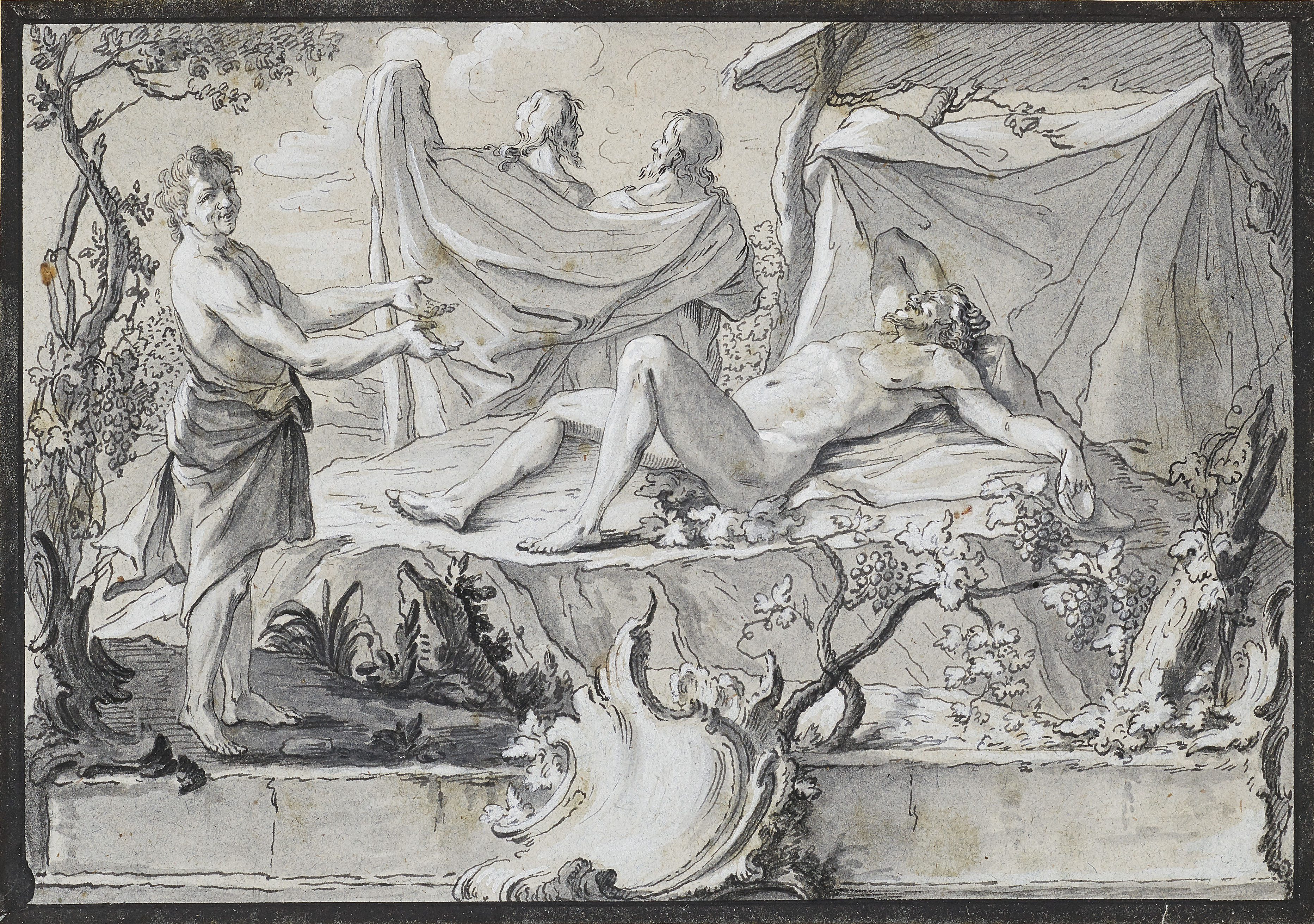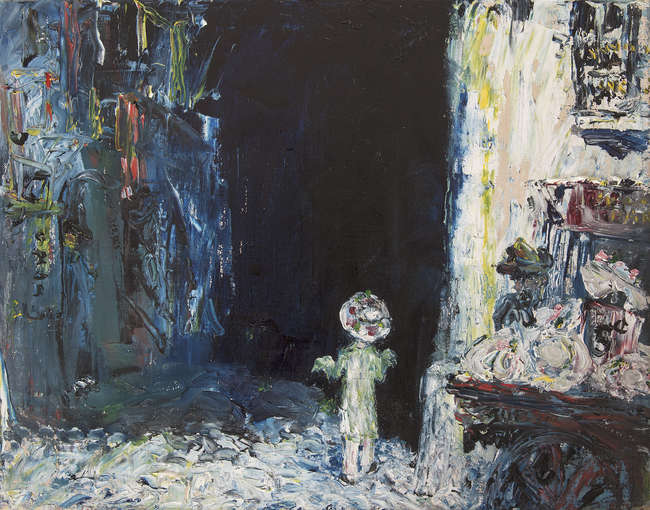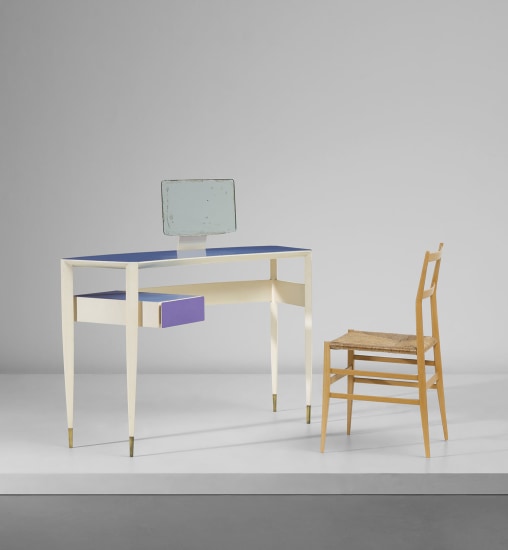Colin Middleton MBE RHA RUA (1910-1983)
Signature: signed lower right; signed, titled, dated and inscribed [Portrush] on reverse
Medium: oil on canvas
Size: 36 x 24in. (91.44 x 60.96cm) Provenance: Family of the artist Exhibited: 'Paintings by Colin Middleton', Ritchie Hendriks Gallery, Dublin, October 1958, catalogue no. 10; 'Colin Middleton: Paintings 1940-1962', Magee Gallery, Belfast, 1962, catalogue no. 23; 'Colin Middleton', Ulster Museum, Belfast, and Hugh Lane Municipal Gallery, Dublin, 1976, catalogue no. 42 Genesis marks the conclusion of one of the most significant and successful periods of Colin Middleton's professional life and is, despite the associations of its title, the last painting in what one might consider his defining series of works during ...Read more Genesis marks the conclusion of one of the most significant and successful periods of Colin Middleton's professional life and is, despite the associations of its title, the last painting in what one might consider his defining series of works during this decade. In 1948 Middleton had begun to exhibit with Victor Waddington in Dublin and remained under contract to his gallery well into the next decade, exhibiting in Dublin, London, Europe and North America and being described by Edward Sheehy in 1954 as 'one of the foremost of contemporary Irish painters'; (1) in 1968 the critic of the Irish Times recollected that 'In the early and middle fifties he was widely felt to be the leading artist in the country after Jack Yeats'. (2) But by 1957 Middleton was no longer working with Waddington, who had just opened his first gallery in London, and had recently taken a position teaching art in Coleraine. Beginning with Jacob Wrestling with the Angel (1948), and continuing with paintings such as Give me to Drink (1949), The Power and the Glory (1949), Isaiah 54 (1949), The Life Everlasting (1950) and Manna (1951), Middleton completed in the decade from 1948, alongside works with other subjects, a small series of powerful expressionist figure paintings which take their titles from the Bible and present a vision of a post-war world full of suffering and redemption, doubt and spiritual triumph, ultimately asserting the survival of mankind and its enduring strength against the backdrop of post-war Europe. This series of paintings defined Middleton's remarkable ambition as an artist and the universality of his vision. In returning to these subjects after a break of six years, Genesis remains stylistically close to the expressive paint surface and intense palette of the earlier works, but there is a starkness and simplicity in the present work, a lack of narrative or of any excess elements, which sets it apart. Genesis is also an exposition of ideas around the female archetype, a crucial and enduring symbol throughout every period of Middleton's painting which transcends the individual to represent the most powerful and enduring forces of generation and regeneration. The female form in the present painting becomes the natural world and the life force, with powerful hands to mould this creation, bringing the mystical and the physical life onto the same plane. There are parallels with the first painting of the series, of which Middleton wrote, 'I do believe that my Jacob's feet (which together with the Angel do not appear in the painting) are firmly planted on the good earth. I further like to feel that there is honest dirt in his fingernails'. (3) Even though one might divide his work into groups of paintings or into periods, he wrote about the enduring continuity between these and the importance of key works that connected these groups. Every so often we produce a masterpiece or integration piece which joins hands with the circle of links, so completing the group… (4) While Genesis seems to sum up the mood and ideas of a particular period, it also looks forward, and it is tempting to wonder whether alongside the universal themes of the painting, Middleton was also considering the new beginnings in his own life at this time, leaving behind a period of enormous change and discovering a new place and a new landscape. Dickon
Colin Middleton MBE RHA RUA (1910-1983)
Signature: signed lower right; signed, titled, dated and inscribed [Portrush] on reverse
Medium: oil on canvas
Size: 36 x 24in. (91.44 x 60.96cm) Provenance: Family of the artist Exhibited: 'Paintings by Colin Middleton', Ritchie Hendriks Gallery, Dublin, October 1958, catalogue no. 10; 'Colin Middleton: Paintings 1940-1962', Magee Gallery, Belfast, 1962, catalogue no. 23; 'Colin Middleton', Ulster Museum, Belfast, and Hugh Lane Municipal Gallery, Dublin, 1976, catalogue no. 42 Genesis marks the conclusion of one of the most significant and successful periods of Colin Middleton's professional life and is, despite the associations of its title, the last painting in what one might consider his defining series of works during ...Read more Genesis marks the conclusion of one of the most significant and successful periods of Colin Middleton's professional life and is, despite the associations of its title, the last painting in what one might consider his defining series of works during this decade. In 1948 Middleton had begun to exhibit with Victor Waddington in Dublin and remained under contract to his gallery well into the next decade, exhibiting in Dublin, London, Europe and North America and being described by Edward Sheehy in 1954 as 'one of the foremost of contemporary Irish painters'; (1) in 1968 the critic of the Irish Times recollected that 'In the early and middle fifties he was widely felt to be the leading artist in the country after Jack Yeats'. (2) But by 1957 Middleton was no longer working with Waddington, who had just opened his first gallery in London, and had recently taken a position teaching art in Coleraine. Beginning with Jacob Wrestling with the Angel (1948), and continuing with paintings such as Give me to Drink (1949), The Power and the Glory (1949), Isaiah 54 (1949), The Life Everlasting (1950) and Manna (1951), Middleton completed in the decade from 1948, alongside works with other subjects, a small series of powerful expressionist figure paintings which take their titles from the Bible and present a vision of a post-war world full of suffering and redemption, doubt and spiritual triumph, ultimately asserting the survival of mankind and its enduring strength against the backdrop of post-war Europe. This series of paintings defined Middleton's remarkable ambition as an artist and the universality of his vision. In returning to these subjects after a break of six years, Genesis remains stylistically close to the expressive paint surface and intense palette of the earlier works, but there is a starkness and simplicity in the present work, a lack of narrative or of any excess elements, which sets it apart. Genesis is also an exposition of ideas around the female archetype, a crucial and enduring symbol throughout every period of Middleton's painting which transcends the individual to represent the most powerful and enduring forces of generation and regeneration. The female form in the present painting becomes the natural world and the life force, with powerful hands to mould this creation, bringing the mystical and the physical life onto the same plane. There are parallels with the first painting of the series, of which Middleton wrote, 'I do believe that my Jacob's feet (which together with the Angel do not appear in the painting) are firmly planted on the good earth. I further like to feel that there is honest dirt in his fingernails'. (3) Even though one might divide his work into groups of paintings or into periods, he wrote about the enduring continuity between these and the importance of key works that connected these groups. Every so often we produce a masterpiece or integration piece which joins hands with the circle of links, so completing the group… (4) While Genesis seems to sum up the mood and ideas of a particular period, it also looks forward, and it is tempting to wonder whether alongside the universal themes of the painting, Middleton was also considering the new beginnings in his own life at this time, leaving behind a period of enormous change and discovering a new place and a new landscape. Dickon


.jpg)












Testen Sie LotSearch und seine Premium-Features 7 Tage - ohne Kosten!
Lassen Sie sich automatisch über neue Objekte in kommenden Auktionen benachrichtigen.
Suchauftrag anlegen